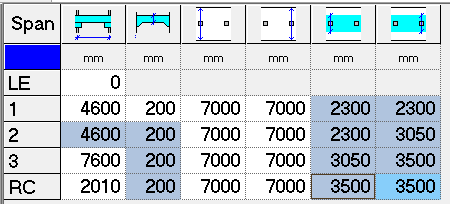arik79
Structural
- Jan 12, 2020
- 11
Hello,
Can anyone provide any guidance/recommendations of correctly assigning the number of tendons in column and middle strips using RAPT
In particular I am struggling to find the best way to assign no. of tendons for situations where the column strips varies in a run
For example, a 3 span run, with constant 5000 slab panel width and with tendons spaced at 1500 centers
Span 1: 2000 long
Span 2: 7000 long
Span 3: 2000 long
Now, what is the best way to assign a 1500 tendon spacing in RAPT? The software only allows a number of tendons for flat plate, no spacing
Should I just conservatively assume the column strip is 1000 for all spans and assign a 0.67 number of tendons for all spans? I think this is too conservative
It would also be incorrect to define multiple tendons and stop and start them at the columns/changes in column strip width as in reality this is not actually happening.
Essentially I want to be able to assign the correct P/A for all three spans with the varying column strip widths. But its very difficult when the number of tendons is fixed for the defined tendon for all spans and there is no option for spacing of tendons.
Thanks in advance for any help
Can anyone provide any guidance/recommendations of correctly assigning the number of tendons in column and middle strips using RAPT
In particular I am struggling to find the best way to assign no. of tendons for situations where the column strips varies in a run
For example, a 3 span run, with constant 5000 slab panel width and with tendons spaced at 1500 centers
Span 1: 2000 long
Column strip width = 1000 (Max column strip width = Span/2 as defined in AS3600)
Span 2: 7000 long
Column strip width = 2500 (not limited by span)
Span 3: 2000 long
Column strip = 1000 (As above)
Now, what is the best way to assign a 1500 tendon spacing in RAPT? The software only allows a number of tendons for flat plate, no spacing
Should I just conservatively assume the column strip is 1000 for all spans and assign a 0.67 number of tendons for all spans? I think this is too conservative
It would also be incorrect to define multiple tendons and stop and start them at the columns/changes in column strip width as in reality this is not actually happening.
Essentially I want to be able to assign the correct P/A for all three spans with the varying column strip widths. But its very difficult when the number of tendons is fixed for the defined tendon for all spans and there is no option for spacing of tendons.
Thanks in advance for any help

